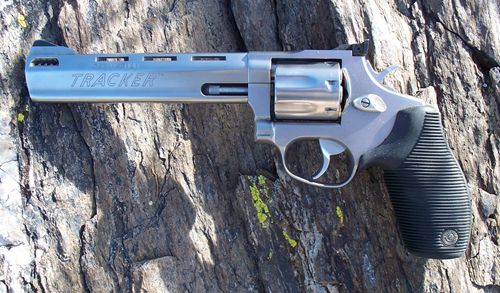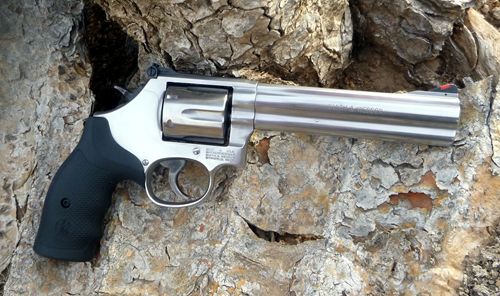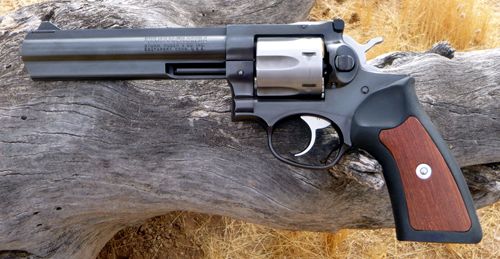Everyone has their own idea, but I would like to present my argument for why a
double-action revolver chambered for .357 magnum, sporting a 6-inch barrel, may
be the best overall choice for a javelina hunting handgun.
Many Arizonans look forward with great anticipation to the spring javelina
hunting season. Arizonans, almost uniquely, love to hunt javelina. Texas and
New Mexico have javelina too, but those folks do not seem to regard javelina
hunting as highly as we do in Arizona. I would say that no one else in the
country “gets” why we love to hunt this strange little pig-like critter as much
as we do.
In Arizona, we have separate Archery, General (any legal weapon), and H.A.M.
(Handgun, Archery, and Muzzleloader) seasons. While you can use a handgun in
the General season if you wanted to, most people who intend to go after
javelina with a handgun do so in the H.A.M. season. The H.A.M. season is just
before the General season, and it is a few days longer, typically 10 days (two
weekends) versus 7 days long for the General season.
Handgun hunting is a popular option to hunt javelina because they are very
stalkable. Their eyesight is not great, though they are said to have an acute
sense of smell. It is quite possible to get within 20 yards of them if you are
careful. I’ve been closer to them than that. They alarm more on your movement,
rather than panicking at the mere sight of you. If they spot you approaching,
freezing in place will often make them forget about you after a while, and they
may continue to go on about their business.
To distribute hunting pressure across the state in accordance with game
populations, Arizona javelina hunt tags are distributed through a lottery
system. September (now) is the month that the spring javelina hunts are
announced and are open to apply for a tag. If you have never tried handgun
hunting before, this is the best hunt to get your start. Hunting javelina in
February in the Sonoran desert, when the desert is green and the temperatures
are cool to mild, is to experience the best of the Arizona outdoors.
When I got started in hunting, my very first big game animal was javelina taken
with a handgun. Not long after that, my son Ben turned 10 years old, eligible
to hunt big game in Arizona. From then through his teen years, Ben became my
primary javelina hunting partner, but we only hunted using rifles. The added
challenge of the handgun was too much for a young hunter I figured.
Eventually, Ben went away to college in Oregon, but Sam attended his first
college year at Arizona State. That year, Sam wanted to try his hand at archery
hunting, so we applied for H.A.M. tags. I’m not an archery guy, so I chose the
handgun. This would be my first attempt at handgun hunting since that first
javelina so many years ago. I ended up getting a piggy, but my tool was a
rifle-caliber (.260 Remington) single-shot specialty pistol, the Magnum Research
Lone Eagle.
Did the Lone Eagle do the job? You better believe it! The critter went down
just as if he were hit by a rifle … because basically, he was. The .260 Lone
Eagle is a handgun only because you cannot shoulder it. It has a 14” long
barrel, a 2-8x variable scope, and when used over a rest, such as shooting
sticks, I had every confidence that I could make a killing shot on a javelina
up to 200 yards away. My shot turned out to be only 40 yards, but that’s beside
the point.
Then what is the point? The answer to that question brings us back to the
essence of handgun hunting, tied together with the stalk-ability of javelina.
The primary challenge of handgun hunting is in getting yourself close enough
to use what is supposed to be a short-range weapon. Don’t get me wrong; a
highly accurate, long range handgun such as the Lone Eagle is a joy to own and
employ, but its long reach just isn’t needed for our little friend, the Collared
Peccary.
The next year, both sons were out of state, away at college, so I had to find
some new hunting partners. Gerhard had an open spot on his spring javelina hunt
application, so I decided to go in with him. Now Gerhard is a die-hard handgun
javelina hunter. I might have preferred to go back to a rifle hunt, but then I
would have to hunt alone. So handgun it was. When we were drawn, I decided to
fully embrace the ethos of handgun hunting. I chose to use my .357 magnum Taurus
Tracker. This Taurus is a double-action revolver with a 6½” long barrel.
At the beginning of this article, I asserted that a revolver of this configuration
is the best javelina hunting handgun, so let me count the ways:
Caliber: .357 magnum is a powerful, but controllable round.
It is the “just right” handgun caliber for javelina hunting. Sure, 9mm, 10mm,
the .41 and .44 magnums are other handgun calibers that will do the job quite
nicely, but .357 is the sweet spot.
Javelina can run a long way after being hit. The key to a quick kill is to throw
a light bullet as fast as you can. A javelina is at max about 10 inches thick
through the lungs. You don’t need a lot of penetration. What you want is immediate
maximum expansion. In .357, you find that in a typical defensive loading, such as
a 125 to 140 grain hollow point. On my last hunt I made the mistake of using a 158
grain bullet, which didn’t expand enough before exiting to put the critter down quickly.
Barrel Length: A barrel length of around 6 inches is also a
sweet spot. A 6 inch barrel gives you a good long sight radius to improve your
practical accuracy. Sure an 8 inch barrel is even better, but may be too much of a
good thing. A 6 inch barrel remains practical for hip holster carry, where an 8
incher starts becoming an unwieldly burden.
Four inch .357s are popular for defensive use, but they give away too much practical
accuracy for a handgun whose primary role is hunting. Yes, your goal is to get as
close as possible, but a shot of 50 yards may turn out to be the best that you can do.
The odds are much better of making a 50 yard hit with a 6 incher than with a 4 incher.
Accuracy: We just talked about the practical accuracy that a
long sight radius gives you, but in my experience, revolvers also possess greater
inherent accuracy than autopistols. Many javelina hunters enjoy the challenge of
using their defensive semi-auto pistols to hunt javelina. I know that accurate
semi-autos exist, it’s just that I’ve never owned one that I would feel comfortable
taking a shot that must count at that extended handgun hunting distance of
50 yards or so.
Honorable Mention: Ruger Blackhawk
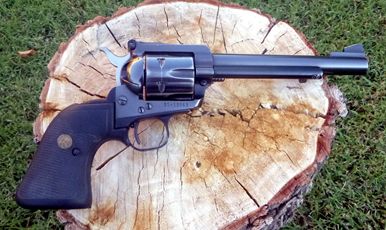
Bob Martin’s “3-Screw” or “Old Model” Ruger Blackhawk Convertible -
.357 Mag/9mm, with Pachmayr grips
|
 Earlier in this story I mentioned that my very first “big game” was javelina taken
with a handgun. That handgun was a 6½” single action Ruger Blackhawk. There’s undeniable
romance in Arizona handgun hunting with an “old west” style of revolver.
Earlier in this story I mentioned that my very first “big game” was javelina taken
with a handgun. That handgun was a 6½” single action Ruger Blackhawk. There’s undeniable
romance in Arizona handgun hunting with an “old west” style of revolver.
 I recently read an article by an author whose opinion is that the Ruger Blackhawk and Super
Blackhawk are nothing less than the perfection of Colt’s design of the famous Single Action
Army revolver. The author says that after the Colt Model 1873 was introduced, any further
design improvements by Colt ceased. When Bill Ruger decided to reintroduce a centerfire
single action revolver to the market in 1955 (Colt had ceased production of the SAA with
the advent of WW2), he made a number of improvements, such as coil springs, improved
adjustable sights, and modern steel.
I recently read an article by an author whose opinion is that the Ruger Blackhawk and Super
Blackhawk are nothing less than the perfection of Colt’s design of the famous Single Action
Army revolver. The author says that after the Colt Model 1873 was introduced, any further
design improvements by Colt ceased. When Bill Ruger decided to reintroduce a centerfire
single action revolver to the market in 1955 (Colt had ceased production of the SAA with
the advent of WW2), he made a number of improvements, such as coil springs, improved
adjustable sights, and modern steel.
 My Blackhawk was a Convertible New Model in .357 with a matched 9mm cylinder. I actually
took the piggy with a 9mm 115 grain JHP. I was able to stalk in to about 15 yards on my
hands and knees before placing the shot. The piggy dropped to the ground instantly and
started thrashing. Soon he was done.
My Blackhawk was a Convertible New Model in .357 with a matched 9mm cylinder. I actually
took the piggy with a 9mm 115 grain JHP. I was able to stalk in to about 15 yards on my
hands and knees before placing the shot. The piggy dropped to the ground instantly and
started thrashing. Soon he was done.
 When I purchased the Taurus Tracker, I gave the Blackhawk to my brother. I really didn’t
miss it, but after our dear friend Bob Martin passed, his Blackhawk Convertible became
available and I took the opportunity to add one back into my collection. Bob’s Blackhawk
is an Old Model, meaning that it retains the famous 4 clicks when you pull back the hammer
(just like a Colt), and is easier to load and unload because the chambers index to a stop
in-line with the extractor rod and the loading gate when you try to rotate the cylinder
backwards.
When I purchased the Taurus Tracker, I gave the Blackhawk to my brother. I really didn’t
miss it, but after our dear friend Bob Martin passed, his Blackhawk Convertible became
available and I took the opportunity to add one back into my collection. Bob’s Blackhawk
is an Old Model, meaning that it retains the famous 4 clicks when you pull back the hammer
(just like a Colt), and is easier to load and unload because the chambers index to a stop
in-line with the extractor rod and the loading gate when you try to rotate the cylinder
backwards.
 The changes to the New Model Blackhawk result in only two clicks when cocking, and no
positive stop for the cylinder when a chamber is in-line with the extractor and loading
gate. But the gun is safe to load and carry with all six chambers filled because of the
addition of a transfer bar safety. The Old Model is effectively a 5 shooter because you
should always leave the chamber under the hammer empty. Load 1, skip 1, load 4, and you
end up with the empty chamber under the hammer.
The changes to the New Model Blackhawk result in only two clicks when cocking, and no
positive stop for the cylinder when a chamber is in-line with the extractor and loading
gate. But the gun is safe to load and carry with all six chambers filled because of the
addition of a transfer bar safety. The Old Model is effectively a 5 shooter because you
should always leave the chamber under the hammer empty. Load 1, skip 1, load 4, and you
end up with the empty chamber under the hammer.
 On both Blackhawks, I installed hand-filling Pachmayr rubber grips which are a huge
practical improvement, though they do detract from the historical good looks of the gun.
The large rubber grips almost make the Blackhawk grip as comfortable to shoot as a
double-action revolver.
On both Blackhawks, I installed hand-filling Pachmayr rubber grips which are a huge
practical improvement, though they do detract from the historical good looks of the gun.
The large rubber grips almost make the Blackhawk grip as comfortable to shoot as a
double-action revolver.
 So due to the shape of the handle and the obvious advantages in loading and unloading a
swing-cylinder, I prefer a double action revolver to the Blackhawk. But there is no
doubt in my mind that the Blackhawk is a damn-fine javelina hunter. If I decide to use
the Blackhawk again for some future javelina hunt, I will use the .357 cylinder instead
of the 9mm. I already did the 9mm thing.
So due to the shape of the handle and the obvious advantages in loading and unloading a
swing-cylinder, I prefer a double action revolver to the Blackhawk. But there is no
doubt in my mind that the Blackhawk is a damn-fine javelina hunter. If I decide to use
the Blackhawk again for some future javelina hunt, I will use the .357 cylinder instead
of the 9mm. I already did the 9mm thing.
|
|
Compared to a single-shot pistol? The single-shot beats the revolver for accuracy
every day. But the revolver beats the single shot in being far more comfortable to
carry. A revolver doesn’t need a sling. It carries in your hip holster. So again,
the 6-inch revolver occupies another sweet spot.
Ergonomics: When hunting, you always use the double-action
revolver in single-action mode by thumb-cocking the hammer. This helps you achieve
the maximum practical accuracy out of the gun. So then why the double-action
revolver over the single action revolver?
This may be a matter of personal preference or personal comfort, but I find that the
ergonomics of the double-action revolver is better than that of the single-action.
The handle shape is significantly different between the two. The handle of the
double-action revolver provides better support to the top of the palm than the grip
of the single action revolver. Dedicated single action shooters tout the way that a
single action rolls in your hand to mitigate recoil. To me, that’s just an unstable
grip. I much prefer the shape of a double-action’s handle.
Carry-ability: I’ve already mentioned the fact that a revolver
can be packed in a holster on your hip, which is a significant advantage to carrying
a rifle, or even the typically large and bulky single-shot handgun. Why is this so
important for javelina hunting? It’s because often javelina live in steep canyon
country where it is a distinct advantage to have two hands free to move the thick
bush out of your way, or to help in scrambling over big boulders, or to help you
balance on steep slopes. If you are used to hunting with a rifle, the liberty of
having two hands free is quite a revelation.
This also explains my preference to leave a scope off my .357 javelina handgun. A
6-inch barreled double action .357 is not a small and dainty tool. It’s big enough
already without hanging a scope on it. A scope defeats the advantage of easy hip
holster carry. With practice, the adjustable iron sights on a good 6 inch double
action revolver will easily do the job for you at normal handgun javelina distances.
With all that I’ve said about the advantages of hip carry, there are some very nice
holster rigs on the market that will allow you to carry the gun across your chest or
belly. If you are hunting with a backpack or pack frame with a wide padded hip belt
for support, the chest or belly rig is actually a better carry method than a hip
holster. That backpack hip belt will get in the way of a belt holster.
A chest or belly rig will allow you to conveniently carry a scoped handgun, even
some bulky single shots. But if you accept the challenge of close range javelina
hunting with an iron-sighted handgun, that doesn’t matter.
So now that I’ve explained why I think that the double action, 6 inch barrel, .357
magnum revolver is the best configuration for a javelina hunting handgun, let’s take
a look at three great examples:
Taurus Tracker Model 627
Though I have owned this one the longest, it is now no longer mine. I sold it to my
son Ben when I was trying to raise money for another gun acquisition. I had an itch
that needed to be scratched.
But I love this gun. By selling it to my son, I still occasionally get to play with
it, so divesting it from my collection didn’t hurt quite so much. He got a good one.
The barrel actually measures 6½” and it is a 7-shooter. It has excellent sights,
including an orange insert in the front sight. That orange spot helps immensely when
you are aiming at essentially a black critter.
Some don’t like the “Ribber” grips that Taurus uses, but I do. I like the way that
the ribs collapse to effectively mold the grip to your exact hand dimensions when you
squeeze. The only negative I could express is that the grip is a little short, but is
not any kind of a problem.
Accuracy has always been greater than I could take advantage of. The front of the
barrel is ported to reduce muzzle flip. The price for one new at your local gun store
will probably be just over $500 out the door.
Smith & Wesson Model 686
Another reason that I was OK with selling Ben the Taurus was that I saw myself
eventually getting the Smith & Wesson equivalent. The Taurus is a good gun, but
the reputation of Smith & Wesson as having superior quality had me wanting to upgrade.
After saying goodbye to the Taurus, for a year-and-a-half, the only .357 in my stable
was Bob’s Blackhawk. I was finally able to herd my resources to put cash on the counter
for a S&W Model 686. Another itch scratched!
S&W makes both a 6-shot and a 7-shot version of this gun. The 7-shot version is
called the 686 Plus. I opted for the 6-shooter, saving $20 which I used to buy a
box of bullets. Sure 7 shots is nice, but there’s really no advantage for a hunting
gun, or for our club silhouette matches.
My 686 is a true 6-inch barrel length, so it is a tad shorter than the Taurus.
Including some distributor exclusives and other special versions, you can get the 686
in 2½”, 3”, 4”, 5”, 6”, 7”, and in the past, even an 8 inch barrel length. The
standard versions are 2½”, 4”, and 6”.
The 686 has an adjustable white-outline rear sight and the front sight also has the
orange insert. The sights are very similar to what’s on the Taurus. Since Taurus
revolvers started as S&W clones under license, the method of opening the cylinder is
also identical on both, so operation is very familiar to me.
The grips I believe are made by Hogue for Smith & Wesson. They feature a pebble
texture and the grip is longer but smaller in circumference than the Ribber grips on
the Taurus. Nevertheless, the grips offer a nice hold.
Now for the price. I paid just under $800 with a 5% military discount out the door
at my local gun store. I could have saved maybe $100 by buying used off Backpage or
shopping around a little more diligently. I don’t regret buying new, paying full cost.
I expect this gun to actually go up in value by the time I no longer need it.
Ruger GP100
This one just sort of fell into my lap. Since my ardor for military surplus rifles
has cooled since my red-hot passion of several years ago, I find myself with a surplus
of military surplus. I’ve been slowly thinning the herd by taking one or two to the gun
show whenever I get a chance. So at the last gun show I took an excess Swiss K-31. The
value on these has gone up considerably since the time that I bought it, because the
supply has dried up.
I had a couple of lookers as I completed the first lap of the gun show, but it seems
that everyone interested was in the same boat that I was: gun rich but cash poor.
When I was in the middle of my second lap, a couple of the guys found me again to take a
second look. One guy finally asked me if I was interested in a trade. “What you got?”
“A GP100.” “4 inch or 6 inch?” “6 inch.” “Let’s take a look.” After a quick look over,
I said, “Sure, I’ll take that deal.”
I only wish that he would have found me two weeks earlier, as then I wouldn’t have
shelled out $800 on the S&W! I certainly didn’t need the GP100, but I was getting ready
to leave the show at that point, and that seemed like a pretty good deal to me.
After getting home, I looked up the serial number on the Ruger website and determined
that this specimen was made in 2004. It’s the blued 6” version which is Ruger model
number 1704. But strangely it has a silver-grey cylinder. Searching the web, I can find
no reference that the 1704 was ever available with a silver cylinder. Could it be a
distributor special? I have no idea, but it sure looks good.
Other than some missing bluing at the muzzle, the gun is in excellent shape. The gun
wears Ruger’s fat rubber grips with the wood inserts. Ruger stopped equipping the .357
GP100 with these grips in early 2008. Since then the .357s ship with Hogue Monogrips.
The GP100 also has an adjustable white-outline rear sight, but a solid black front sight.
Fortunately, the front sight on a GP100 is made to be easily changed and a red insert
front sight is available on ShopRuger.com for $16.
New, the out-the-door street price for a GP100 will probably be in the $600 to $700 price
range.
Sam will likely end up as the owner of this gun. But for now, there’s no telling when
he will next be able to go on an Arizona handgun javelina hunt with his brother and I.
How do they compare?
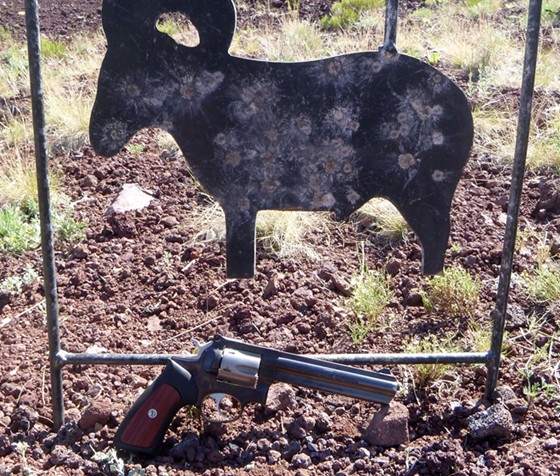
For an informal shooting comparison, I took the three guns up to a favorite cinder pit
in the Flagstaff area one weekend this summer. I set up a ram silhouette swinger at what
turned out to be 46 yards. The plan was to take ten shots from each gun standing offhand,
to count how many hits I could make with each.
Before shooting for record, I took a number of practice shots with each, which included
some fine-tuning of the rear site adjustment until I was hitting reliably with a dead-on
hold. Here’s how they did:

So what does this tell us? Basically that any of the three will make a fine javelina
hunting handgun.
I’ve rarely seen this talked about before in the context of single action handgun trigger
release, but it is something that I noticed. Comparing the single action trigger release
of these three plus the Blackhawk, the Blackhawk has the slowest, longest, and heaviest
hammer drop. The next slowest is the GP100, then the Taurus, and finally, the S&W’s is
the lightest and fastest. I’m talking strictly about the action of the hammer drop after
the trigger is tripped.
It seems like the slow lock-time of the Rugers means a greater opportunity for the sights
to drift off the point of aim after the trigger release, and the greater momentum of the
hammer strike could upset the hold on target before the bullet leaves the barrel. We’re
talking hair-splitting differences, so I can’t say if this is a real-world problem.
Summing up
I’m going to use that word again: ethos. It comes down to why you are using a handgun to
hunt. Maybe you just want to have the extra weekend of the H.A.M. hunt over the general
hunt. But really, hunting with a handgun is a choice to purposely limit and challenge
ourselves.
But there are levels of challenge within that choice. If you want hunt with your concealed
carry gun, you will have to get real close. If you have a hand rifle, there’s a lot of
satisfaction with making a relatively long kill with a firearm that has no shoulder stock.
But a revolver might be the most traditional of all handguns. There is no intent here to
badmouth handgun hunters who choose something other than the 6 inch .357 for handgun
javelina hunting. Heck, I love my single shot, and may yet go after the little piggies
with my CZ-75 clone one day. I’m just saying that sitting between the defensive autopistol
and the hand rifle, the 6 inch .357 magnum revolver hits the sweet spot as the best choice
overall.

![]()
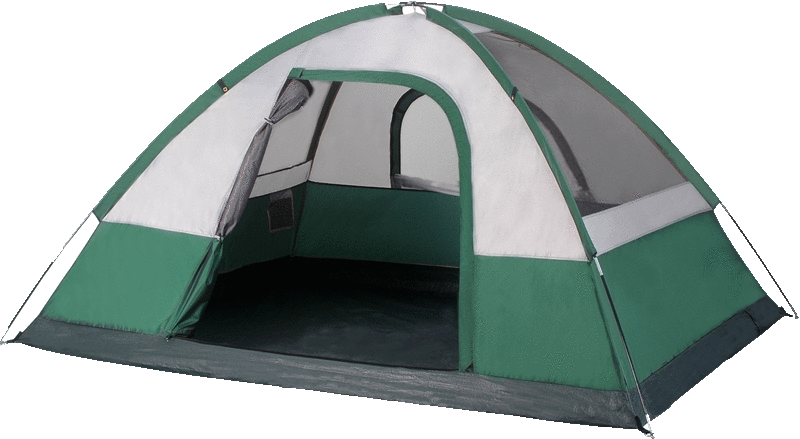
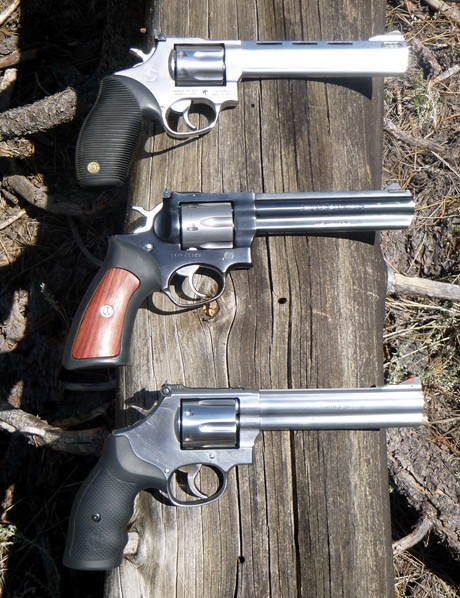
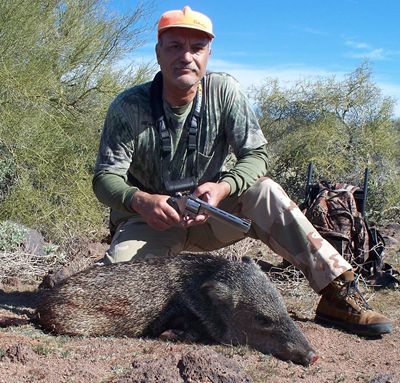

 Earlier in this story I mentioned that my very first “big game” was javelina taken
with a handgun. That handgun was a 6½” single action Ruger Blackhawk. There’s undeniable
romance in Arizona handgun hunting with an “old west” style of revolver.
Earlier in this story I mentioned that my very first “big game” was javelina taken
with a handgun. That handgun was a 6½” single action Ruger Blackhawk. There’s undeniable
romance in Arizona handgun hunting with an “old west” style of revolver.
